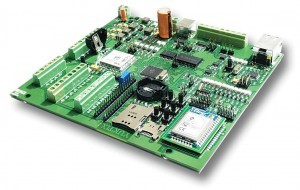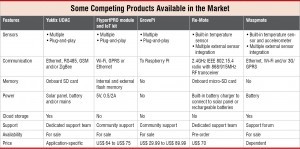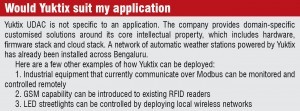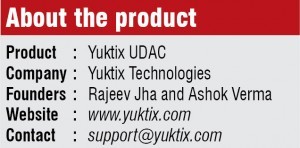The Internet of Things (IoT) applications capture data from the physical world, communicate this data to a central server and run analytics on it. In order to complete the IoT loop, the user has to select sensors, choose a compatible platform to plug in those sensors, write the firmware, select data protocols, establish communication to the server and ensure security of the transferred data.
Problem arises when the user wants data related to machine utilisation, power consumption, temperature of the system and excess vibration in machines, and store this data on a computer system, access it on a mobile phone, get instant alerts and share these reports with other concerned people.
The machine-to-machine (M2M) market today is very fragmented. Creating such systems requires disparate skills from multiple vendors. It is a time-consuming process and the budget cannot be calculated beforehand. So how can we make the system-creation process simple, know what will one receive and at what cost?

The solution
The Yuktix Universal Data Acquisition and Control (Yuktix UDAC) platform comprises hardware and software that connect industrial equipment, machines and sensors to the Internet in a plug-and-play model and let users control field devices from a central dashboard. It can be used for a variety of purposes including the following:
1. Connect industrial protocol equipment to the Internet, customer relationship management and enterprise resource planning systems
2. Collect physical data such as temperature, vibration, stress and pressure
3. Establish solar-powered off-grid units to collect sensor data
4. Control units deployed in the field from a central location
5. Take decisions based on sensor data
Given below is a step-by-step guide to how the solution works:
1. Select the sensor(s) required for an application from the catalogue of compatible sensors provided
2. Plug the selected sensor(s) on the small form factor board
3. Upload the firmware provided
4. Power the board using a solar panel, lithium-polymer battery or mains electricity
5. Connect it to the cloud gateway using either a wired (Ethernet, RS485, etc) or a wireless (GSM, ZigBee, etc) solution
6. Start getting data collected by the sensors on Yuktix cloud, Yuktix Android app or external cloud services such as Amazon Web Services (AWS) and Zoho

More features
Yuktix has a secure digital (SD) card memory onboard. There is an external random access memory (RAM) that increases the power of onboard processing. It also has general-purpose input/output pins to interface with multiple digital and analogue devices and sensors. By powering the device on battery or solar energy and transmitting data over Global System for Mobile Communications (GSM), you can make a true off-the-grid system.
You can also set up a wireless (ZigBee) sensor mesh network with solar power in order to collect physical data from regions that have no network coverage or even electricity.

Buying a highly-efficient development board with varied functions would not be of much help to an inexperienced user. Cost of programming often surpasses the cost of the development platform itself. Moreover, the quality guarantee of some software is very weak compared to the hardware and can result in escalating maintenance. This is when the team decided to provide customers with a stable and simple firmware along with Yuktix board.
Designing such a device that covers multiple domains was a real challenge, according to the team. Understanding and covering the sensor and protocol requirements, providing both off-grid and grid power solutions, developing the hardware and a supporting PCB, and placing the radio module on the board without introducing noise to the measurements, were to be achieved keeping the form factor into consideration. Developing such an interoperable device from scratch was tough, and it took about four iterations and 1.5 years to get the device to the market.
Why Yuktix
 There are many IoT boards available in the market. These only address a part of the solution provided by Yuktix. With such boards, cost of programming and risk cannot be ascertained beforehand. Also, IoT boards primarily target developers and DIY makers. Typical DIY makers and hobbyists never consider the time and efforts. However, the same is crucial for corporations’ budgets.
There are many IoT boards available in the market. These only address a part of the solution provided by Yuktix. With such boards, cost of programming and risk cannot be ascertained beforehand. Also, IoT boards primarily target developers and DIY makers. Typical DIY makers and hobbyists never consider the time and efforts. However, the same is crucial for corporations’ budgets.
According to its developers, this product is the only end-to-end solution available for industry-level IoT projects. With out-of-the-box solutions for firmware, data capture, communication protocols, cloud connectivity, server layer and Android application provided along with UDAC platform, these offer a comprehensive solution to its customers.
The high-end remote terminal units (RTUs) will do about 20 per cent and wireless data loggers will do 10 per cent of what Yuktix offers. But the issue here is that these are not plug-and-play solutions. With similar solar-powered devices, the user would be constrained with a specific set of sensors. Also, the reprogramming and solution development cost for all such offerings would be very high, says the team. But Yuktix provides the firmware and mobile application, thereby saving the cost of programming.
Future releases
Next version of Yuktix will have over-the-air (OTA) features and would implement chips having security as part of the core. The team also plans to remove the power supply module, stack the interfaces and make it plug-and-play to reduce the size.














